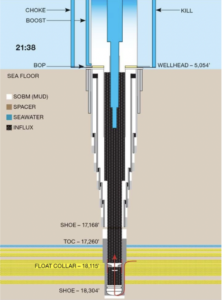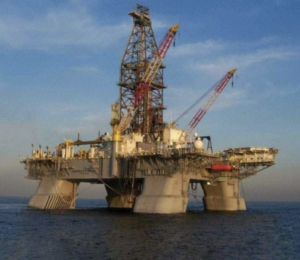The Deepwater Horizon Oil Spill of 2010: How it Happened
Written by: Maneth Perera
April 10, 2010 at approx. 7 pm, on the Gulf of Mexico off the coast of Louisiana… A board of BP (British Petroleum) executives sat in a room on the Deepwater Horizon oil rig situated in the Macondo reservoir in the Gulf of Mexico. The crew had just finished yet another successful operation, where they moved to different reservoirs in the ocean and drilled the seafloor to create a hole filled with oil. Later on, this oil can be extracted by another crew. The execs congratulated the Deepwater Horizon crew and presented them with rewards for 7 whole years without a lost-time incident (no major worker injuries). Shortly after, the executives met with the Captain on the bridge, but the oil rig started to violently shake amid their conversation. The group rushed into a room on the deck before they saw mud and gas pouring in droves onto the rig’s floor.
By then, it was too late to prevent the disaster from happening in front of their eyes. The blowout preventer, a multi-valve system used to seal off the well and prevent massive overflow, had already been surpassed by mud, hydrocarbon gas, and oil. The expanding gas shoved fluid out of the well at massive speeds, and this gas ignited on contact with the rig pump motors’ electrical circuitry. At around 9:50 pm, the first explosion happened as pieces of drilling machinery were broken into bits and gallons of mud and oil splashed overboard. How did this devastating accident happen? What oversights did multiple technical crews make when drilling the oil well, and how could this have been prevented?
Oil Rig Mechanics
To understand exactly what happened, we need to understand the typical process for drilling an oil rig. Oil rigs are large structures created onshore before being floated out to sea. They have many parts such as cranes and living quarters for the crew, but what’s most important is the drilling equipment. A tower contains a hoisting system to lower down a drill bit attached to a drill string. This drill bit is lowered with a casing to be deposited in the topmost layer as the drill bit goes deeper. Then a subsequent casing with a smaller diameter is lowered into the hole below the initial casing. Smaller and smaller casings are lowered until the drill bit reaches the oil layer. Cement is pumped down into the hole and moved through tubes so that it goes in a U-turn and starts filling up the empty ring of space between the casings and the rock layers, which secures all of the casings. A nose (cement base) is made at the very bottom of the hole when the oil layer is reached and valves are implanted in the last casing so that the oil can be harvested safely. Later on, another ship visits these wells and uses specialized pumps to harvest the oil deep inside.
Figure 1

A schematic of the oil well (the “influx” is hydrocarbons and gas that ignited the flames and kept the fire going).
Source: The Chemical Engineer
Safety Tests and Measures
To test the safety and stability of an oil well, multiple tests are used to check how well the cement job has been done. Mud is pumped out of the hole and replaced with seawater later on. Only a small bit of mud is pumped out at this stage to test if the hole would collapse when this is done. The pressure in the hole is then tested to make sure the hole is stable, and this is called the negative pressure test. When a cement job is done incorrectly, small air bubbles get trapped inside the cement. Using an acoustic logger, the cement is struck to test the reverb and see if there are any empty spaces inside (think hitting a wall to feel if there is a space behind it). A positive pressure test is also employed in which the well is pressurized for a given period to test if the pressure stays stable or if a leakage causes the pressure to drop suddenly.
Lastly, a blowout preventer (BOP) is attached to the top of the well. When oil is harvested like this, sometimes the high pressures can cause bursts of oil to accelerate up the hole and through the casings due to gas pockets moving them up. This is called a kick, and if the oil and gas are pressurized enough they can shoot up into the oil rig and ignite with the electrical equipment (sparks + fuel = fire + explosion), causing a catastrophic explosion. BOPs prevent these disasters by having multiple airtight closing mechanisms, including pipe rams, which shove pieces of metal into an airtight position to close off the well. Blind shear rams are a special type of pipe ram that uses shears to cut the drill string off, and these came into play during the disaster.
With all of these safety measures, one would assume that oil rig disasters should be easy to avoid. It’s not like the entire crew ignored the signs of an impending kick and subsequent explosion, right?
Ignoring the Signs
In February of 2010, drilling commenced at the Macondo reservoir. From the start, multiple bad signs had presented themselves. The drill pipe, a pipe used to extract the dirt pushed out by the drill bit, got stuck in the wellbore and had to be ripped out. Drilling mud had started leaking out of the hole on multiple occasions (called “lost circulation events”) and smaller kicks had happened due to gas unexpectedly moving into the well from the surrounding rock. The fragile rock formations at the reservoir made drilling slower and more costly, causing the project to fall behind by almost 45 days by April 20th.
Unfortunately, the engineering team made a few unusual decisions. Instead of a normal liner–which is a lot easier to cement together–that connects the steel casing to the section above, they used a long-string steel casing that connects back up to the surface. Along with that, they only used 6 centralizers instead of the usual 21–centralizers are machines that centralize the steel casing so there is even space around it in the well. This made the cementing job a living nightmare for the cementing team as the casing ended up decentralized and slightly leaning to the side. The rock around the well was already very fragile, so if they cemented the steel casing wrongly, they could cause the entire well to collapse.
Therefore, they decided to pump the cement in slowly, decrease the volume of cement they would use, and use a special foamy cement full of nitrogen gas to decrease the density. The primary cementing job was eventually finished on April 20th and the pumps were turned off. They started doing the safety tests to make sure the well was intact and not prone to collapse.
Further Testing
The positive pressure test? Check. The well stayed at a constant pressure of 2,500 psi for a full 30 minutes, indicating no leakage and a good cement job. The audio log test? Check. The negative pressure test? Nope. The well’s pressure spiked to over 1,200 psi on the first test, a major sign that fluids were moving into the well from the surrounding rock layers. The test was run 3 more times with a psi of over 1,000 every time. At this point, the engineers should have realized that the bottom cementing job had been done wrong, and then should have attempted to redo the cement job. Yet, they proposed that the denser mud had weighed down on top of the seal between the casings, causing a higher pressure. From this assumption, they decided that they must go on and that the project was safe enough to finish up.
Figure 2

A picture of the Deepwater Horizon before the incident.
Source: The Chemical Engineer
Disaster Strikes
Unfortunately, the night before they were set to seal the hole and leave, a kick of devastating proportions occurred. Luckily, they still had time to see the signs and activate all of the valves in the blowout preventer to stop the gas and oil from making its way out. Some of these signs include the volume of mud increasing at an alarming rate, flowmeters showing an imbalance of fluids flowing in/out of the well, and a steadily rising drill pipe pressure. These signs were ignored from 8 pm to 9 pm, but at around 9:15, when the mud pumps pushing mud out of the well were shut off, the engineers on the rig noticed something. The drillpipe pressure was rising sharply even when the mud pumps were shut off. The engineers, instead of immediately activating the BOP, shut off the pumps to investigate. They did not want to ruin the well by using the BOP, but this fatal mistake allowed material to spew out of the well. When mud and oil started spewing onto the rig floor, it was already too late. They attempted to activate the blind shear rams (only one of the many pipe rams) in a desperate attempt, but further investigation after the matter found that the blind shear rams likely malfunctioned and punctured the tube, causing more high pressure oil to spill out into the ocean.
Conclusion
Many more explosions occurred on the rig after the first one, and a rescue attempt was launched at around 5 am. The fire raged on for more than a day before the oil rig finally sank on April 22, but the oil kept spilling out of the open well for almost 87 days before the well was finally sealed up. The explosion of oil and gas not only caused the deaths of 11 people and the injury of 17, but also one of the worst ecological disasters in human history with approximately 134 million gallons of oil spilled into the Gulf of Mexico. Entire ecosystems were nearly wiped out from the amount of oil that was mixed into the surrounding waters, and a desperate cleanup effort by BP amounted to barely any oil recovered from the water and contamination continuing to spread. Only when multiple environmental agencies stepped in was the situation finally under control. To this day, the Deepwater Horizon oil spill serves as a testament to the cautiousness required when working with volatile Earth structures, and the severe ecological impacts oil and natural gas mining can have on the environment.
References and Sources
3D Living Studio. “How Offshore Oilrigs Work, Float, and Extract Oil.” YouTube, 20 July 2022, www.youtube.com/watch?v=FsbTZoyzID8&ab_channel=3DLivingStudio. Accessed 15 Apr. 2024.
British Petroleum Company PLC. “BP Releases Report on Causes of Gulf of Mexico Tragedy.” BP, 8 Sept. 2010, www.bp.com/en/global/corporate/news-and-insights/press-releases/bp-releases-report-on-causes-of-gulf-of-mexico-tragedy.html. Accessed 15 Apr. 2024.
Maitland, Geoff. “Deepwater Horizon: As It Happened.” The Chemical Engineer, 26 Mar. 2020, www.thechemicalengineer.com/features/deepwater-horizon-as-it-happened/. Accessed 15 Apr. 2024.
Pallardy, Richard. “Deepwater Horizon Oil Spill.” Encyclopedia Britannica, 13 Apr. 2019, www.britannica.com/event/Deepwater-Horizon-oil-spill. Accessed 15 Apr. 2024.
Cover Photo from Encyclopedia Britannica
1 thoughts on “The Deepwater Horizon Oil Spill of 2010: How it Happened”